Water storage tanks have a variety of benefits and incorporating them on your property is a wise choice. However, taking time to do your homework pays big dividends in ensuring your chosen water tank can meet the unique challenges on your property.
Types of Rainwater Tanks
1. Poly (polyethylene)
2. Fibreglass
3. Concrete
4. Metal
Are all these water tanks created equal? We'll leave it up to you to decide in this comparison below.
Poly Rainwater Tanks
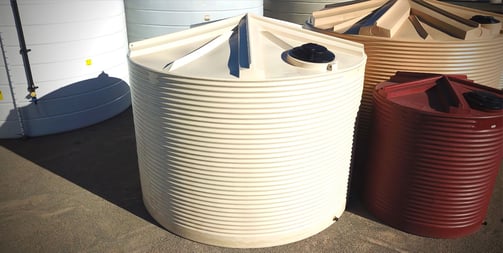
Advantages:
- Come in many different sizes, shapes, colours, combinations and with multiple connection possibilities. They can go either above or below ground.
- Lightweight making them easier to transport, position or move according to necessity. No heavy equipment necessary.
- Lightweight doesn’t mean weak. Quality poly water tanks are built to withstand harsh climate conditions and resist UV damage.
- Adaptable and easy to relocate.
- Built as a one-piece construction, meaning there are no seams to cause weak points.
- 100% resistant to rust and corrosion.
- Resists algae growth.
- Are the 2nd cheapest after metal. But poly is more cost-effective as it outlasts metal.
- Faster, easier, and cheaper installation. In fact, out of all water tank materials, poly is the easiest to install.
- Non-porous.
Poly water tanks don’t leach any chemicals or lime that may impart a taste in the water or damage the material through pores on the walls of the tank. - Built using non-toxic, high quality, food grade polyethylene. Also built in compliance to AS/NZS 4020 that involves testing of products for use in contact with drinking water.
- Less prone to cracking compared to fibreglass or concrete.
Disadvantages:
- At the end of their life-cycle (known to be more than 30 years), proper recycling is necessary.
However, plastic water tanks can have a new life as something else, not necessarily water storage.
- High fire risk – It is important to note that most tanks including poly tanks risk failure in a fire, just as any building, pump or pipework would, unless they are in a fire break zone. If your tank out survives your building, what good was the tank?
Related topic:
Top 4 Poly Water Tank Problems and the Solutions You Need to Understand Now
Fibreglass Water Tanks
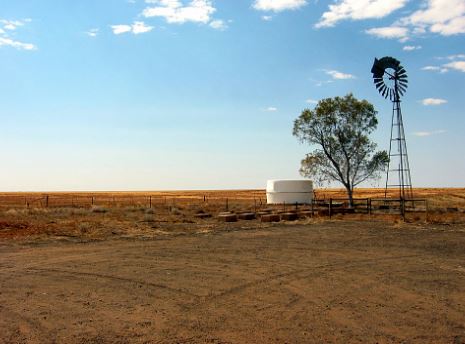
Advantages:
- Available in multiple sizes and work both above and below ground.
- Non-porous, just like poly water tanks.
- Fibreglass doesn’t corrode, but some parts may be prone to localized corrosion.
- Easy to install compared to concrete water tanks.
- Resistant to chemicals, something that fibreglass has in common with poly.
Disadvantages:
- Allows more light penetration which increases the likelihood of algae growth.
- Requires an external UV-resistant gelcoat. If this coating is damaged, it can reduce the life of the tank.
- Fibreglass is a very rigid material. This has both an advantage and a disadvantage. Whereas fibreglass can manage water pressure well, overtime its rigid and inflexible nature may give way to brittleness, leading to leaks and cracks.
This is in stark contrast to flexible poly tanks which can adapt/expand to water volume and bounce back to shape – literally – with impact.
- Fibreglass water tanks are hand-crafted, requiring pieces to be connected, forming seams (unlike poly water tanks which are built as a one-piece vessel, eliminating seams).
The seams in fibreglass tanks can get damaged or separated over time, weakening the overall structure of the tank and predisposing it to leaks.
- Because fibreglass water tanks are hand-crafted, there is always the possibility for human error during production. In other words, the process is highly dependent on individual skill, which may result in some inconsistencies across tanks.
- Cost: They are more expensive than poly tanks.
Concrete Water Tanks

Advantages:
- Concrete tanks can be built above or below ground, available in different sizes and capacities, pre-cast and transported to the site or built on-site.
- Long-lasting.
- Have maximum strength due to reinforced steel in the concrete.
- Concrete itself doesn’t rust. Unfortunately, the reinforcing mesh does. More on this below.
- Excellent insulating properties keeping water or liquids cooler.
Disadvantages:
- Concrete water tank construction is energy-intensive making them more expensive to build and requiring more people and heavy equipment during installation.
- Concrete water tanks are heavy and thus, difficult to move around. If you’re planning to incorporate some changes on your property, your plan must be reworked in consideration of the concrete tank.
- Concrete water tanks are extremely porous.
Newly constructed concrete tanks may impart taste in the water or leach lime. Lime increases the pH in water. When pH reaches alkaline level, water in the tank may be prone to developing toxic algae.
Concrete can develop pores, which is a great place for bacteria to thrive in. You can have a concrete tank sealed to reduce this possibility, but that’s an additional expense! - Concrete tanks can easily develop cracks and leaks.
You may think cracks in concrete are fairly easy to repair with applications of waterproof paint, membrane or resin. However, these applications do not prevent future cracking at all.
Furthermore, hairline cracks on the surface of a concrete tank might not seem like much, but these cracks actually extend through the entire breadth of the tank.
With cracks, water in the tank can find their way through deeper layers of the concrete, causing further damage. Overtime, the reinforcing mesh can rust and be eventually exposed and rot.
Repairing cracks involve emptying a concrete tank and the application of a plastic liner in worst case scenarios. Note that plastic liners are quite expensive.
So, before opting for a concrete water tank, consider all the expenses: installation, protection, repair, and even removal when it’s past its lifetime or relocation when you need to incorporate changes on your property.
Metal Water Tanks
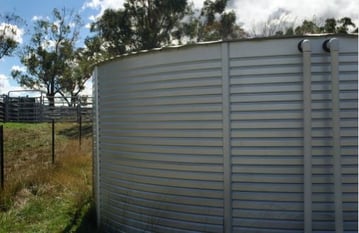
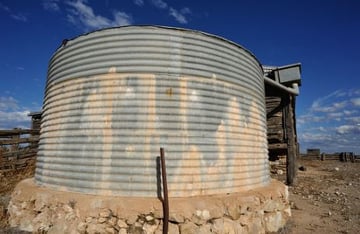
Advantages:
- There are many sizes and capacities available and they can withstand harsh conditions including fire.
- Material is UV resistant.
Disadvantages:
- Galvanised steel is coated with zinc for protection against corrosion. They're also sold with food-grade polyethylene liners to prevent the zinc from mixing with the liquid contents, consequently giving water a metallic taste. Overtime, the liner could break and need repair. You need to be more cautious when cleaning this type of tank so as not to damage the lining.
- In contrast, stainless steel water tanks are protected from corrosion but are much more expensive than galvanised steel.
An important note to make for both galvanised and stainless steel is that their screws, rivets and soldered joints may not be rust-resistant.
- Corrugated steel tanks cannot be placed underground.
- Moving the tanks once they are in place is difficult.
- Ground work before installation can be costly and involves extensive preparation when compared to other tank types.
- Less impact resistant, unlike poly, which can bounce back to shape with impact.
Related article:
Why Rotational Moulding of Poly Water Tanks is a Big Deal
Water Tanks Cost Guide and Pricing Guide
Take these key differences into consideration when making your decision about which water tank suits your needs best. We’d love to answer any questions you have about available options, so contact us today.
Editor's Note: This post was originally published on February 20, 2017 and has been revamped and updated for the purpose of accuracy and comprehensiveness.





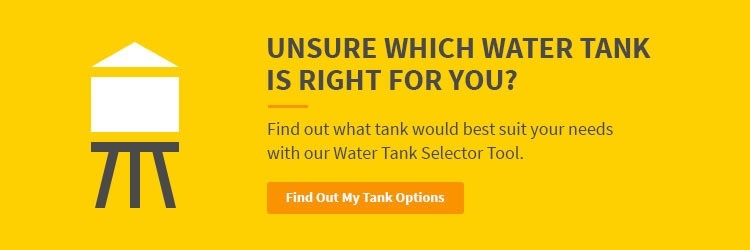

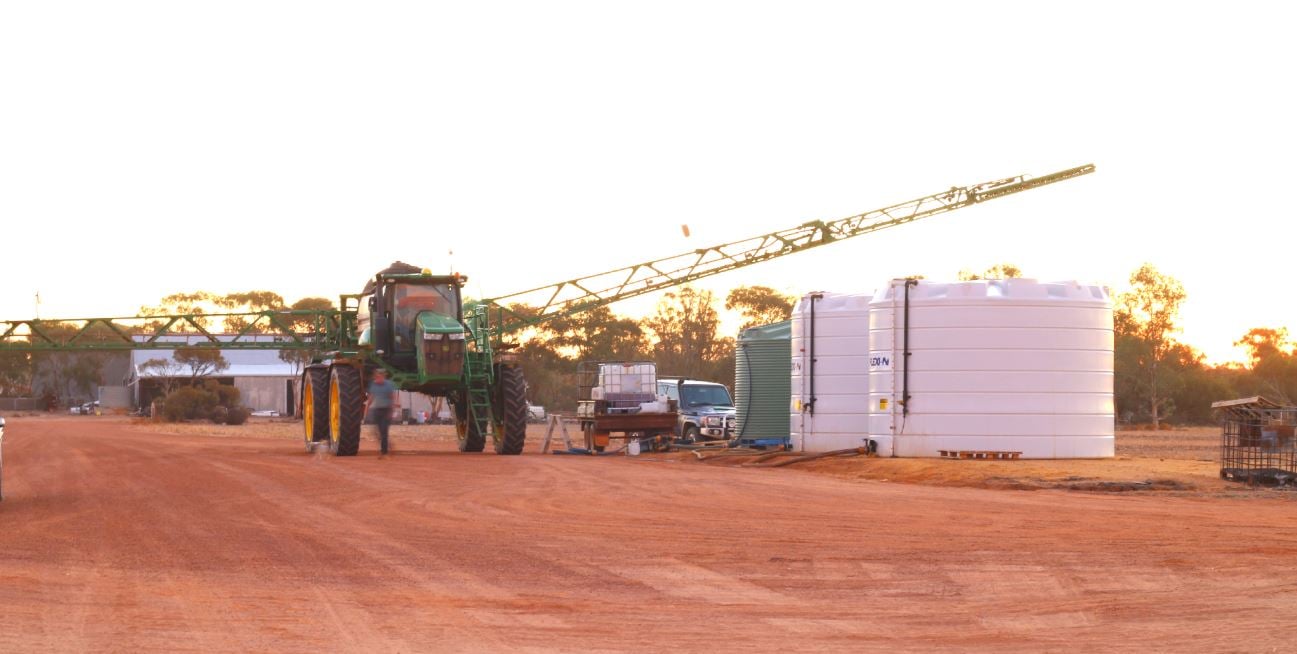

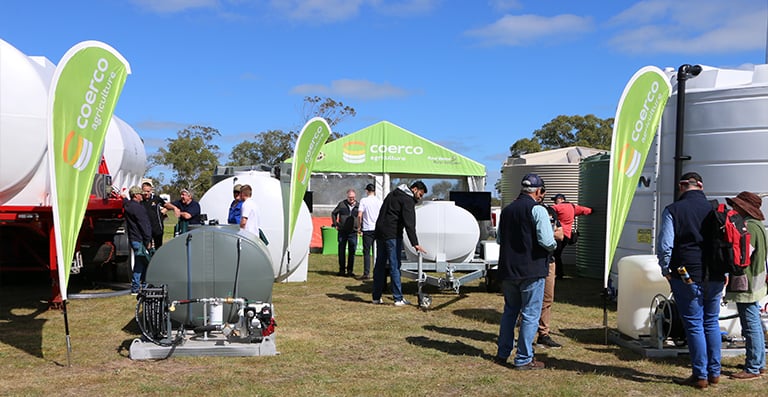
What do you think about this post?
Comments